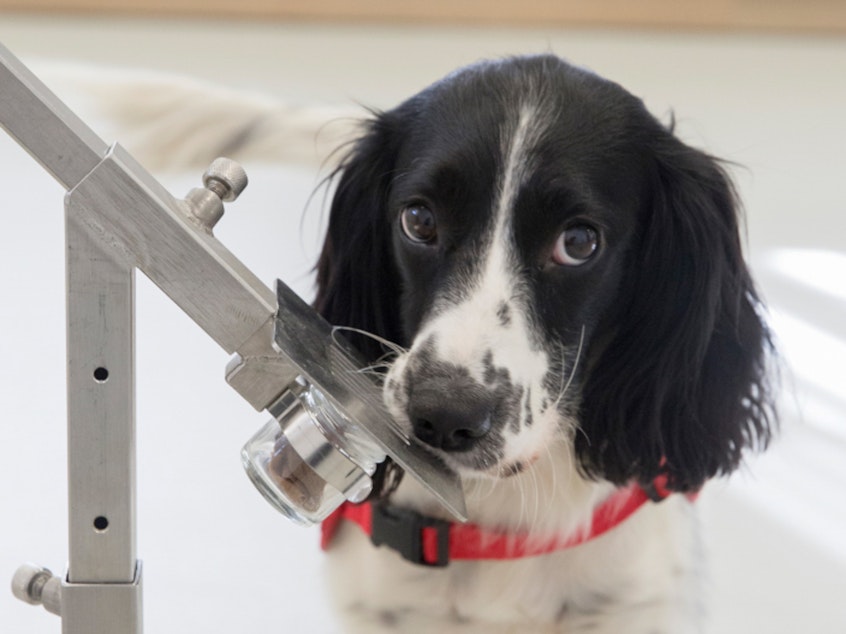How A Dog Could Stop The Global Spread Of Disease

Several years ago, British entomologist Steve Lindsay landed at an American airport and was immediately struck by all the furry creatures walking around the baggage claim area.
"I was astounded to see sniffer dogs, looking for fruits and vegetables," says Lindsay, who studies malaria at Durham University in the U.K.
Recent studies have found that people carrying malaria release a signature scent. "So I thought, 'Well, if a dog can smell fruits and vegetables in luggage, could they smell malaria in a person?' " Lindsay says.
So he set out to create the ultimate disease watchdogs — canines that can smell parasites living inside people.
Then, as people hop off international flights, these watchdogs could take a few sniffs at each person's skin and paw at the people who might be carrying a parasite. "The person can be taken aside and possibly tested for the disease with a blood test," Lindsay explains.
Sponsored
Sound far-fetched? Well, it might not be as far from reality as you would think.
At a scientific conference on Monday, Lindsay presented preliminary evidence that dogs can detect whether a person is carrying the malaria parasite in their blood by just sniffing their odor — or more specifically, sniffing a small piece of their sock. The researchers trained the dogs by rewarding them with a snack when they correctly identified and sat next to a malaria-tainted sock.
Lindsay and his colleagues trained two dogs — Sally the Labrador retriever and Lexi, a golden retriever-Labrador mix. Although the study was small, the results were encouraging. Overall, Sally and Lexi had a success rate of about 70 percent for picking out the socks worn by people with malaria; each dog correctly identified at least 21 of the 30 samples.
The dogs did better with the socks worn by people not infected. Each dog correctly identified at least 131 of the 145 negative samples, for a success rate of about 90 percent.
Clearly, larger studies are needed, Lindsay says. But the dogs' performance isn't too shabby when you look at how well some commercial tests perform. For example, one study found rapid diagnostic tests correctly detected malaria 60 to 90 percent of the time, depending on the particular conditions. And the tests correctly identified the negative samples about 90 percent of the time — which is similar to the dogs' performance.
Sponsored
And Sally and Lexi have room to improve, Lindsay says. "We made it hard for the dogs," he says. "We didn't have many samples to train them with — just 30 socks worn by people with malaria. "
Lindsay hopes that trained dogs could, one day, work at ports of entry to help countries keep malaria from entering, especially in places that are trying to eliminate the parasite or have just gotten rid of it.
"At the moment, malaria detection relies on taking a person's blood with a pin-prick, but you can't do that to everyone coming across a border," Lindsay says. "The malarial dogs would be a non-invasive method of picking up the parasite."
But there's still quite a bit a work to do before you'll find Sally and Lexi sniffing your legs at customs areas and baggage claims. For starters, the researchers don't know if the dogs can actually pick up the scent on a person's skin in addition to their socks — and whether the dogs are able to differentiate between a malaria infection and an infection caused by another pathogen.
Finally, Lindsay and his team haven't tested whether or not the dogs can detect different species or strains of malaria found in various parts of the world.
Sponsored
Still though, if you think about it, the dogs are doing something remarkable, Lindsay says: They're detecting the presence of a microscopic organism living inside a person's blood — or liver — by simply taking a sniff of a sock. [Copyright 2018 NPR]



